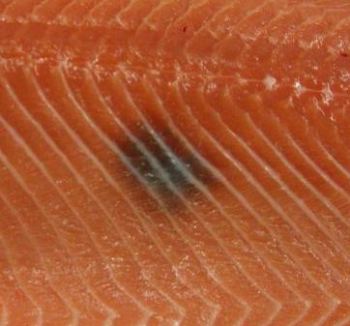|

Photo credit: Nofima
What do we know about dark spots in the salmon fillet?
 NORWAY
NORWAY
Saturday, March 21, 2020, 15:40 (GMT + 9)
Why do salmon sometimes get dark spots in the filet? Is it dangerous to eat? This and more questions are answered in a FAQ about melanin stains in the salmon fillet
The farming industry is paying great attention to and seeking to understand the underlying causes to quality deviation related to dark discoloration of salmon fillets. The discoloration can appear as distinct dark spots or as diffuse grayish discoloration. Occasionally discolored muscle is seen under the skin.
 fis_com.jpg)
Photo: NMBU
Occurrence of dark spots in salmon fillets
- Most spots are up to 3 cm wide and a few mm thick, located in the front part of the fillet
- Dark discoloration is observed in wild caught salmon
What is melanin?
- Melanin is a group of natural pigments found in most living organisms
- Melanin pigments act as natural antioxidants
.jpg)
Photo: Marel
Causes of dark spots in salmon fillets
- Melanin is the main pigment causing dark discoloration
- Melanin pigments are deposited as a response to tissue damages or local inflammation that develops over time
- Melanin deposition is a natural part of the fish's immune system
- The causality is complex. According to the state of knowledge, handling during slaughter, genetic background/breed or vaccine adverse reactions are not believed to be major causes to the problem
Is melanized tissue safe to eat
- No harmful compounds are detected in melanized tissues of salmon fillets
- Dark spots are considered a quality deviation and are normally cut out and discarded
.jpg)
The Marel QC Scanner is an efficient and accurate device for checking the quality of your salmon fillets after filleting and trimming, or after skinning.
HOW IT WORKS
- A 2D vision camera rapidly scans the surface of each fillet and detects melanin and blood spots, trimming and skinning defects, and levels of brown meat. It can also identify the color of selected areas to color grade the fillets according to industry standards.
- A 3D vision camera estimates the fillet weight by measuring volume.
Research on dark spots
- The Norwegian Seafood Research Fund (FHF), on behalf of the fish farming industry, is supporting research on dark spots to reveal causes and define measures to mitigate the problem. The research was intensified in 2012, and involves several industrial stakeholders and research communities. Additionally, private companies have their own ongoing research projects
- Research projects initiated by FHF have identified mitigating factors that have been implemented by the industry. In particular, the prevalence of large, problematic spots has decreased.

Project partners FHF 901487
Author: Maja Bævre-Jensen/NOFIMA
[email protected]
www.seafood.media
|



